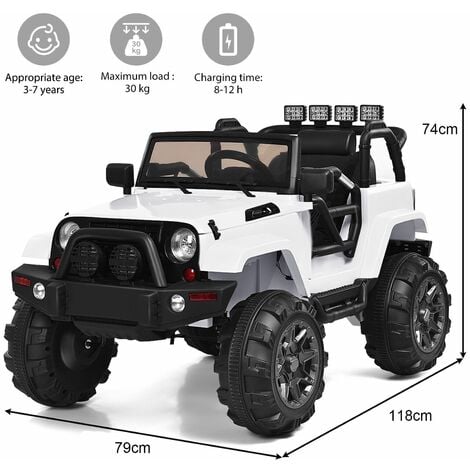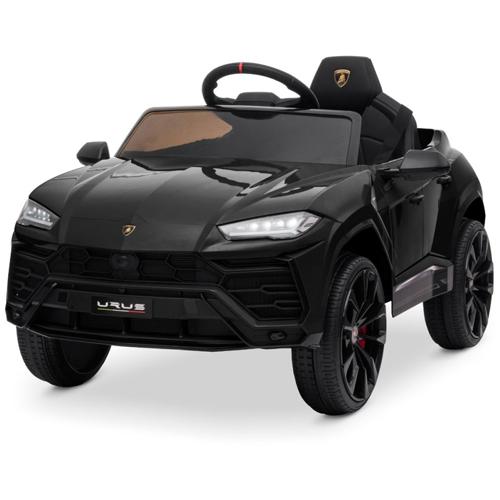New Reasons On Choosing Electric Kids Cars
New Reasons On Choosing Electric Kids Cars
Blog Article
What Do I Need To Know About The Battery Life And Charging Times Of An Electric Kid Ride-On Vehicle?
Understanding the battery's lifespan and the charging time of an electric ride-on children car is crucial to ensuring uninterrupted playtime and optimal performance. Here's what you should know - Battery Type -
Most electric ride on cars for children are powered by rechargeable batteries. They can be either lead-acid or Lithium-ion. In general, rechargeable lithium-ion batteries offer more battery life and longer lifespan as well as faster charging times than lead-acid ones.
Battery Capacity
The size of the battery and capacity, expressed in amperehours (Ah) or watthours(Wh) will determine the amount of time a car can be operated with one charge. Larger capacity batteries offer longer playtime before needing to recharge.
Run Time -
The run-time of an electrical ride-on vehicle is the length of time it can run continuously on one charge. The running time of an electric ride-on automobile will vary depending on the factors like battery capacity and motor power. It also depends on the terrain and the amount of weight the driver.
The typical time to run electric ride-on vehicles is between 30 minutes and two hours. Certain batteries with a higher capacity may provide an extended run time.
Charge time -
The charging time is how long it takes the battery to completely recharge once it has been exhausted. Charging times can vary depending on the battery's capacity, charger specs and the charging technique.
In general the time to charge electric vehicles is between 8 to 12 hours. Certain models offer faster charging speed, particularly with lithium-ion batteries.
To ensure safety and a long-lasting battery life, it is essential to charge the battery in accordance to the manufacturer's instructions. The performance of the battery and its longevity is affected by either overcharging it or undercharging it.
Charge Methods Charge Methods
Chargers for electric ride-ons are usually plugged into the standard outlets in your home. Certain models come with fast-charging capabilities, or they may come with a charger that changes its charging rate based on the state of the battery.
To avoid damaging the battery or the electrical system, ensure that the charger and port of the ride-on is compatible.
Additional Batteries
Certain electric rides on cars offer the option to buy additional batteries or spare batteries for extended playtime. Extra batteries allow you to replace depleted batteries by fully charged batteries, which minimizes downtime.
If you are aware of the charging time and battery life of an electric kids' car and your child can enjoy endless hours of play and adventure. It is important to charge the battery as often as you can and adhere to the correct charging methods. This will improve battery performance. Take a look at the best Mercedes ride on car for website examples including race car toy, cars pedal car, toy and car, toy cars, cars pedal car, car toy car toy, remote control childrens electric cars, toy toy cars, electric ride on, ride of car and more. . 
What Type Of Maintenance And Assembly Requirements Are There For Children's Ride On Vehicles?
It is normal for children' ride-on car to require assembly as well as regular maintenance in order to achieve optimal performance and security. Below are the typical maintenance and assembly requirements for kid's rides-on-cars.
Most ride-on vehicles are assembled, and will require assembly. It usually involves attaching parts such as wheels as well as the steering wheel, seats, and other components according to the instructions of the manufacturer.
Please follow the instructions to assembly in order to ensure that all parts are correctly aligned and attached. Utilize the tools and hardware that are provided to complete the task.
Cleaning -
It is important to clean the vehicle that you ride on frequently to ensure its appearance and function. Use a soft, damp cloth with mild soap and water to clean the exterior surfaces.
Pay attention to the areas that are susceptible to accumulation such as tires, undercarriage and wheels. Utilize a toothbrush or brush to wash hard-to reach areas and remove stubborn grime.
Avoid harsh chemicals and harsh cleaners, as they may damage the coating or the electronic component.
Battery Care -
The battery of the car that rides on it must be taken care of in a timely manner to ensure that it operates effectively and lasts as long as is possible. Use these guidelines regarding battery care
The battery must be fully charged prior to first use and following each use to ensure the longest runtime possible.
Beware of overcharging and not leaving the battery connected with the charger for extended periods. This can cause damage to the battery and decrease its lifespan.
When not in use Keep the battery and cars in a place that is dry, cool, and away from intense temperatures and direct sunlight.
If you have to you need to clean the terminals, use a terminal cleaner or wire brush when they are damaged or corroded.
Replace the battery if it's no longer holding a charge or if you notice signs of damage.
Tire Maintenance -
Be sure to check the tires on a regular basis for indications of damage, wear, or loss of air pressure. Tires can be inflated to the recommended levels using a bicycle, or an air compressor.
The tread pattern must be checked for foreign objects, debris, or other obstructions that can cause flats. Repair or replace damaged tires by clearing any obstructions.
Lubricate the wheel bearings and axles regularly to reduce friction and ensure smooth movement.
Occasional Repairs or Replacements -
Ride-on cars can require repairs or replacement parts due to wear and tear or damages.
Watch for signs of malfunctions, including unusual noises, a decrease in power, or an unsteady performance. Contact customer support or follow the manual from the manufacturer to assist in troubleshooting.
Replace worn-out or damaged parts promptly to prevent any further damage, and ensure the safety and performance of the ride-on automobile.
These assembly and maintenance instructions can help keep your child's car ride in good condition and allow them to have a safely and have fun. Take a look at the best JCB ride on digger for more examples including kiddies cars, two seater childrens electric cars, riding digger, electric ride on cars, toy in car, childrens digger, toy toy cars, remote control childrens car, ride ons, toy ride and more. . 
What Is The Best Way To Determine An Amount To Spend On A Ride-On Car For Your Child?
When you are deciding on a budget, you should consider factors like features, durability, longevity and your financial position. Find the best price for your budget by doing some research about average prices.
Before you start, look up the price range of a ride-on child's car with the features you are looking for. Pricing information is available on the websites of the manufacturers and online toy stores as well as retailers.
What are the Must-Have features?
Decide which features your child requires for their safety and enjoyment. Ride-on cars with features like realistic sound effects, belts for seats, remote control, and working headlights can be more expensive.
Prioritize features according to your child's interests and budgetary constraints.
Consider the durability and long-term sturdiness -
Look for ride-on cars made from durable materials such as premium plastics or metals that are able to withstand daily use and outdoor conditions.
Check reviews and get recommendations from other parents to assess the longevity and long-term performance of different models. The upfront expense of a reliable ride-on vehicle can save you money in the long run by avoiding regular repairs and replacements.
Compare prices among retailers
Shop around and compare prices of different retailers to discover the best value for your money. Check out special offers and prices from department stores, online retailers and specialty stores.
Keep an eye out for any discounts, sales or clearance sales. They can allow you to get a better deal on your purchases while not sacrificing their quality.
Include additional costs in your budget -
Be sure to include any additional costs you may incur when purchasing a ride-on child's car. These include shipping charges and taxes, as well as any additional accessories (e.g. extra batteries, safety gear).
Plan the cost for the entire amount, including any accessories or maintenance expenses.
Create a budget that is real
Set a budget that is practical and in line with your goals and requirements. Consider durability, features and long-term use when setting your budget for a car ride.
Spending too much money on features that aren't needed or that do not add value to the experience of your child is not recommended.
Be aware of the long-term value
A ride-on kids' car which is robust, dependable and can grow with your child can be an excellent investment. It could be worthwhile investing in a more expensive model with more features over the long-term.
When you are looking to purchase a ride-on for your child's vehicle, establish an amount of money you can afford and then compare features, durability and length of time. This will allow you to find the most value for dollars. While staying within the budget, focus on aspects that are crucial to your child's safety and fun. Follow the best ride on toys kidscars.co.uk info for site tips including pedal car, toy car, car electric ride on, toy car, childs car toy, childs car toy, car toy toy, toy with car, pedal car, kids electric cars and more. .